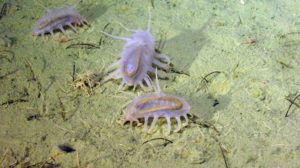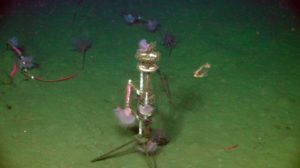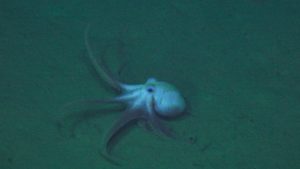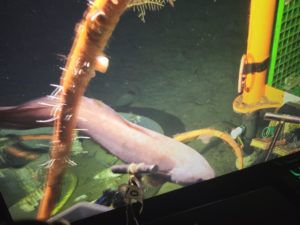Deep beneath the ocean’s surface, life persists in a realm of perpetual darkness. For many, the impression of this vast sediment-laden oceanscape is that the seafloor is a barren “desert”, yet in fact, it is teeming with life. Here, most life forms swim slowly through the near freezing water, conserving energy.
Over the past decade, the RCA team has had the privilege of observing this hidden world through the “eyes” of the ROVs ROPOS and Jason during site and instrument surveys. Among the many fascinating creatures this trip include octopus, Seapigs, Venus Flytrap Anemones, Sea Pens and larger animals that include octopus, cuskeels, and rattails. Each organism plays a crucial role in the deep-sea ecosystem. During this Leg 1, we have spent many hours in this often mysterious environment, watching with amazement the critters that thrive 9500 ft beneath the ocean’s surface.
Seapigs: With no eyes and stubby, little, legs Scotoplanes or sea pigs are a common sight on the deep seafloor at many of the sites along the Regional Cabled Array. endlessly wandering, (in a not-so-graceful manner), across the soft sediment in search of food. They are members of the phylum Echinodermata, (literally “spiny skin”), and close relatives of other sea cucumbers. Possibly their most defining characteristic is the “legs” they use to stumble along the seafloor. While all echinoderms have tube feet or podia, sea pigs have special enlarged tube feet that are powered by a biological hydraulic system in their bodies. Special sacks in their skin ringed with muscles contract and extend, pushing and pulling water like a pipette bulb to move the legs. Like other sea cucumbers, they are deposit feeders and use the small tentacles of their faces called buccal podia to sift through the sediment on the deep seafloor and pick out the pieces of food to eat, which includes poop and mucus. Some species have also been observed to seek out larger food sources such as whale falls and can amass in huge groups of up to 600 individuals.
Venus Fly Trap: The Venus Flytrap Anemone is named for its resemblance to the carnivorous plant. The deep sea flytrap captures prey with its tentacles that are lined with stinging cells called nematocysts. By feeding on small invertebrates and organic particles, the Venus Flytrap helps to regulate the populations of other species and contributes to the nutrient cycling process in the deep sea. These anemones are commonly found on our instruments and extension cables where they patiently wait for prey to drift into their tentacles. Their predatory behavior is essential for maintaining the balance of the deep-sea food web.
Sea Pens: Sea Pens are observed at numerous sites along the Regional Cabled Array – the Oregon Offshore, Slope Base, and Axial Base sites. They are fascinating colonial marine cnidarians (related to anemones, jellies, and corals). These organisms serve as both habitat and food for a variety of species. Sea pens anchor themselves in soft sediment, where they filter plankton and particulate matter from the water. Their rigid structure provides shelter for small fish and invertebrates, while their vibrant colors add to the visual diversity of the deep-sea floor. Sea pens are also preyed upon by nudibranchs and sea stars, linking them to the broader food web of the deep sea.
Octopus: Several octopuses have been seen at the OOI RCA sites including at Axial Seamount, but a consistent sighting is the Deep-Sea Octopus (Muusoctopus sp.) that we see at Slope Base. They are carnivorous and live on the seafloor commonly laying and brooding their eggs on hard or sheltered substrate they can find – including the OOI RCA equipment. Despite their beauty and larger than life appearance in our images, these octopus are actually quite small. Their heads are around 6 inches across, and their total length is around 15 inches. This small stature doesn’t stop the octopuses we come across from rearing up and spreading their tentacles to make themselves seem as big as possible. This is likely a defense mechanism to try and scare off potential predators.
Pudgy Cuskeel: Spectrunculus grandis also known as the “pudgy cuskeel” to its friends is a large, eel-like, bony fish rarely seen by humans that inhabits the seafloor in some of the deepest waters around the Regional Cabled Array at depths often exceeding 2000 meters. Pudgy cuskeels are one of the largest bony fishes in the deep oceans, often exceeding more than a meter in length and remain close to the seafloor, slowly swimming to conserve energy as the roam in search of food. Cuskeels and their relatives are often solitary and have been observed to live in burrows or caves but may also be closely associated with tubeworm colonies at hydrothermal vents. Most of their lives consists of hunting for food which includes crustaceans, snails, worms, and any other detritus they may come across on the seafloor. While the exact reproductive characteristics of the pudgy cuskeel is unknown given how rarely they are seen, members of this species are thought to be egg-bearing and release their eggs in a buoyant raft made of mucus. This little boat for their offspring is thought to carry the eggs far away from the parent and reduce intraspecies competition. Individuals are also thought to be able to produce a sound to help aid in mating with acoustic surveys often able to pick up large congregations of shallower water cuskeels. Other species of cuskeels produce this low resonance by using a modified air bladder and backbone to act as a resonating chamber, and its possible that the pudgy cuskeel may exhibit similar behaviors in the deep ocean where it can be difficult to find a mate.
Rattail Fish: Macrouridae or Rattail fish get their name from their large heads with large mouths and eyes and long tapering body that end in a rat-like tail. They are one of the most common fish living near the seafloor in the deep sea having been seen between 200 and 7,000 m (660-22,970 ft) from the Arctic to Antarctica. At the OOI RCA sites they are a common sight in Axial Caldera and at Axial Base and Slope Base. The family is very diverse with 28 known genera, so the rattails we see are likely from a number of different species. While many of the rattails we observe are fairly small (between 8 in to 2 ft), a particularly notable species of rattail we have seen on occasion at Axial Caldera is the Giant Rattail (Albatrossia pectoralis) which, as its name suggests, is a particularly large rattail that can grow to be more than 6 feet long. Rattail species feed in many different ways, but generally are predators or scavengers eating smaller fish, crustaceans, and even cephalopods. They often visit the ROV while it is working for a meal, hunting the animals disturbed by our work or scavenging the food stirred up by the ROV’s movements. An example of this was seen during J2-1609 at Slope Base, when we observed a rattail hunting while waiting for the ship to move into position to lift Jason and the heavy junction box below it.

Poop-filled sea pens forage alongside sea pens, brittle stars, and very small shrimp at 4050 ft ~60 miles west of Newport Oregon. Credit: UW/NSF-OOI/WHOI; V21.

Venus flytraps colonize a current meter a 9500 ft at the Slope Base site. Credit: UW/NSF-OOI/WHOI; J2-1608; V24.

White, gray and purple Deep Sea Octopus – Muusoctopus sp. walking along the sea floor. Credit: UW/NSF-OOI/WHOI; J2-1609; V24.

Screen shot of a Pudgy Cusk eel sighted at 2900 m. Credit: UW/NSF-OOI/WHOI; J2-1609. University of Washington, V24.
Recent Updates